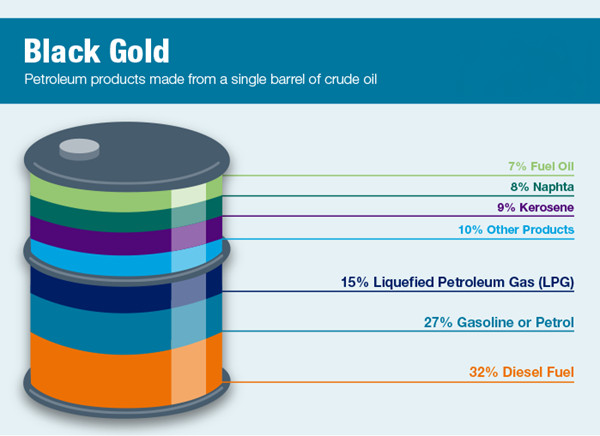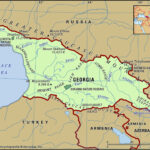Crude oil, often dubbed “black gold,” conjures images of thick, dark liquid gushing from oil rigs – raw and unrefined from the earth’s depths. This nickname is well-earned, considering the vast array of products derived from this unrefined resource.
From gasoline and diesel powering our vehicles to heating oil warming our homes, and a spectrum of petroleum products like naphtha, waxes, and lubricating oils, crude oil is integral to countless products we use daily.
But where does this essential substance originate? Let’s delve into the origins of crude oil and explore five crucial facts about this vital Earth resource. First, let’s establish some key facts.
_1.jpg)
Quick Facts About Crude Oil
Crude oil is a naturally occurring fossil fuel, meaning it is formed from the remains of ancient organisms. It is primarily composed of hydrocarbons – molecules made of hydrogen and carbon atoms. Crude oil exists in liquid form within underground reservoirs, trapped in the minute spaces within sedimentary rocks, and can also be found closer to the surface in oil sands.
Frequently found alongside natural gas and saline water, crude oil is often used interchangeably with the term “petroleum.” However, “petroleum” is a broader term encompassing both unrefined crude oil and refined petroleum products. Crucially, crude oil is a non-renewable resource; once depleted, it cannot be easily replenished.
Petroleum Products from a Single Barrel of Crude Oil:
 Infographic of products derived from crude oil
Infographic of products derived from crude oil
Unveiling the Origins: Where Does Crude Oil Actually Come From?
Crude oil is formed from the remains of microscopic marine organisms called diatoms, including algae and zooplankton, that thrived millions of years ago in ancient marine environments.
These organisms were the dominant life forms on Earth during that era.
Important Fact: Contrary to popular myths, dinosaurs were not around during the primary period of oil formation. Therefore, the notion that fossil fuels originate from dinosaurs is inaccurate.
During their lifespan, these organisms harnessed solar energy and stored it as carbon molecules within their bodies. Upon death, their remains sank to the ocean or riverbeds, becoming buried under layers of sediment, mud, and rock.
Over vast geological timescales, these organic remains were buried deeper and deeper under increasing layers of sediment and organic matter. The immense pressure, elevated temperatures, and absence of oxygen triggered a transformation of the organic material into a waxy substance known as kerogen. With further heat, pressure, and time, kerogen undergoes a process called catagenesis, converting it into hydrocarbons.
The specific combination of pressure, heat, and the original composition of the organic material determines the type of hydrocarbon formed. In this instance, the resulting hydrocarbons constitute crude oil. Other hydrocarbons that can form include asphalt at lower temperatures and natural gas at higher temperatures. Once formed, oil migrates through tiny pores in the surrounding rock from areas of high pressure to low pressure, often moving upwards. Some oil may reach the surface and pool naturally, while in many cases, it becomes trapped beneath impermeable layers of rock or clay, forming underground reservoirs.
How Deep Beneath the Earth’s Surface is Crude Oil Found?
It might seem that oil is continually being sourced from ever-deeper levels of the Earth. However, the reality is that oil, if anything, has consistently migrated upwards over geological time. The increasing depth of oil drilling is primarily due to the depletion of shallower, more accessible oil reservoirs. In 1949, the earliest year with available data, the average depth of oil wells drilled was approximately 3,500 feet.
By 2008, this average depth had increased to 6,000 feet. Remarkably, the deepest oil well currently extends to a staggering 40,000 feet – exceeding the height of Mount Everest by 11,000 feet. It’s important to note that drilling isn’t always vertically straight down; “depth” refers to the total distance drilled, which can include significant horizontal stretches.
Finding Black Gold: How Do We Locate Oil Deposits?
Geologists are the experts in oil exploration, employing various techniques to identify areas likely to contain oil traps – the coveted “black gold.” Oil is frequently found in extensive underground reservoirs located in regions that were once ancient seabeds, both beneath land and offshore under the ocean floor.
In the early days of oil exploration, geologists relied on studying soil, surface rock, and other surface features to infer potential oil deposits below. Advances brought satellite imagery and sophisticated technologies like gravity meters, magnetic field sensors, and “sniffers” capable of detecting hydrocarbon odors.
Today, the most prevalent method involves generating seismic waves that travel through rock layers and reflect back to the surface. These reflections are then analyzed to identify geological structures indicative of oil traps. Seismic sources include compressed-air guns, thumper trucks, or even controlled explosives. Once a promising location is identified, geologists mark it using GPS coordinates on land or marker buoys at sea.
Global Oil Production: Which Countries Are the Top Producers?
According to recent data from the International Energy Agency (IEA), global oil production averaged 100 million barrels per day in 2018. This figure comprises 32 million barrels of crude oil alone, and 68 million barrels of crude oil, condensates, natural gas liquids (NGLs), and oil from unconventional sources.
The top five oil-producing nations account for over half of the world’s crude oil output. As of 2019, the leading oil-producing countries are:
- USA – 17 million barrels per day
- Russia – 12 million barrels per day
- Saudi Arabia – 10 million barrels per day
- Canada – 6 million barrels per day
- Iraq – 5 million barrels per day
Peak Oil and Remaining Reserves: How Much Oil is Left Globally?
With oil production continuing to rise over decades, experts are constantly evaluating when, or if, the world will deplete its oil reserves. This is a complex calculation, as the exact amount of oil trapped in unexplored regions remains unknown.
However, BP has provided an estimate based on “proved reserves” – the amount of oil each country believes it can extract profitably using existing technology at current extraction rates. Their projection indicates that if current conditions persist, oil production could cease around 2067. This suggests a remaining timeframe of roughly 48 years at current rates.
It’s crucial to recognize that such “peak oil” predictions have historically been pushed back due to new discoveries, technological advancements, and shifts in consumption patterns.
Life After Oil: What Happens When Oil Reserves Decline?
As Charles Darwin observed, adaptation to change is essential for survival. While human civilization can undoubtedly survive beyond oil, the consequences of declining oil production could necessitate significant changes in modern society as we know it. Our dependence on oil extends far beyond transportation and energy.
Oil is a fundamental component in nearly every facet of our lives, from the transport and production of food, clothing, and materials, to pharmaceuticals and the plastics used in countless products. The magnitude of societal change will heavily depend on the rate of oil decline and the development and adoption of viable oil alternatives.
The rate of decline is difficult to predict. Enhanced oil recovery techniques and the economic viability of previously inaccessible oil sources could extend oil availability for many years. A sudden, catastrophic “peak oil” scenario, as often depicted in doomsday predictions, seems less likely.
However, rising oil prices are a plausible consequence of more complex and expensive extraction methods, coupled with increasing global supply and demand. Despite environmental concerns, demand for oil has consistently risen over the past decade and is projected to grow further. Rising prices may incentivize consumers to seek more cost-effective alternatives and drive innovation in production and refining efficiency.
The future of oil suggests it will remain a critical resource for the foreseeable future. Societal shifts may be driven more by economic factors and the search for cost-effective alternatives than by a sudden, voluntary global shift away from oil, given its deeply ingrained role in modern life. Therefore, continued research into alternative resources and enhanced efficiency in our current resource utilization are crucial.
Howden equipment plays a vital role in numerous oil and gas processes, including refining, petrochemical production, and transportation. We are committed to developing innovative products and systems that meet and exceed environmental standards while delivering optimal results.

